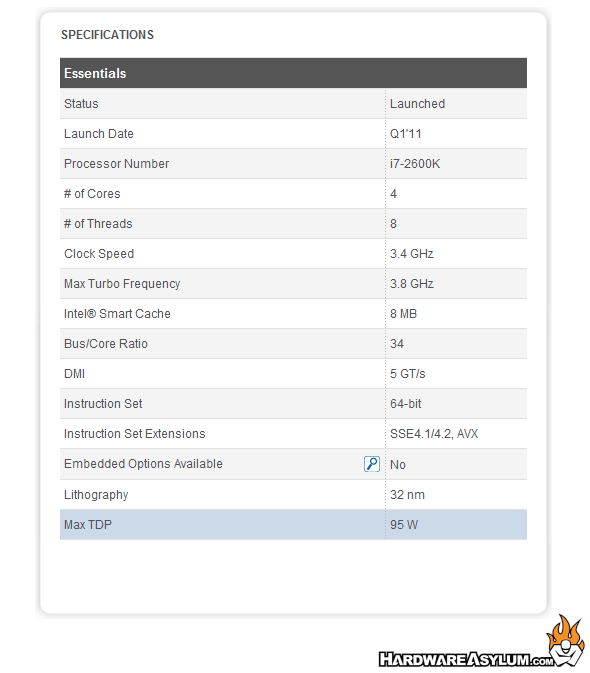Noctua NH-L9i Low Profile Heatsink Review
Author: Dennis Garcia
Published: Thursday, February 07, 2013
Benchmarks
The Noctua NH-L9i is designed for low power Intel Socket LGA 1156 / 1155 processors. Here is an overview of the system and testing methodology.
The system as it was tested
Asus P8Z68 Deluze Gen3 Intel Z68 Chipset
Intel Core i7 2600K (3.5Ghz) Quad Core 4 x 256KB L2 Cache 8MB L3 Cache
Noctua NH-L9i
Intel Stock Heatsink Fan
The CPUID System Monitor was used to obtain and record system temperature data and being that this is a quad core processor we need something that will work across all of the cores at once. For this task we're using a new version of Prime95 (p95v255a) that will allow you to spawn (n) instances to test with.
Intel Core i7 2600K (3.5Ghz) Quad Core 4 x 256KB L2 Cache 8MB L3 Cache
Noctua NH-L9i
Intel Stock Heatsink Fan
The CPUID System Monitor was used to obtain and record system temperature data and being that this is a quad core processor we need something that will work across all of the cores at once. For this task we're using a new version of Prime95 (p95v255a) that will allow you to spawn (n) instances to test with.

Editors note: Even though the Windows 7 task manager reported 100% processor usage we could never attain a 100% of the rated heat output as documented by Intel (see below) when using Prime95 as a basis for that heat production. Knowing this we ran the stress test until the maximum temperature was attainted and stabilized.
Other things to consider when judging software induced heat output.
a) Clock throttling by the processor at high temperatures.
b) Normal software isn't designed to produce maximum heat output.
c) Variances of cooling temperature.
d) Variances in CPU load.
e) Inaccuracies in thermal diode readouts.
Of course the list goes on..
Our testing methodology is aimed to provide a real world look into this heatsink given the test system provided.
Other things to consider when judging software induced heat output.
a) Clock throttling by the processor at high temperatures.
b) Normal software isn't designed to produce maximum heat output.
c) Variances of cooling temperature.
d) Variances in CPU load.
e) Inaccuracies in thermal diode readouts.
Of course the list goes on..
Our testing methodology is aimed to provide a real world look into this heatsink given the test system provided.
Adjusted Speed
For this test we took our stock 2600K and downclocked the processor (Yes, we know) to simulate a lower powered CPU like what the NH-L9i is designed for. To do this we lowered the multiplier to x27, disabled Turbo and HyperThreading. This in turn lowered the processor voltage to 1.08v. Our target for this test was 65w.


To calculate a new C/W rating for this test we will need to factor in the change in processor wattage. The formula and constants for this are listed below.
ucC/W = dCPU Watts * (ucMhz / dMhz) * (ucVcore / dVcore)2
ucMhz = 2760
dMhz = 3500
ucVcore = 1.08
dVcore = 1.2
dCPUw = 95W
The variance still applies for our C/W calculation
Allowed variance for this test = 85%
CPU Watts = 61W
0.37 C/W = (41C - 22C)/(.85(61W))
ucC/W = dCPU Watts * (ucMhz / dMhz) * (ucVcore / dVcore)2
ucMhz = 2760
dMhz = 3500
ucVcore = 1.08
dVcore = 1.2
dCPUw = 95W
The variance still applies for our C/W calculation
Allowed variance for this test = 85%
CPU Watts = 61W
0.37 C/W = (41C - 22C)/(.85(61W))
Benchmark Conclusion
In our heatsink and waterblock tests we don't really focus on overall load temperatures but rather how well the product can remove heat given a specified heat load. Since this is a real world testing method we need to take into consideration real world variables and estimate tolerances. This is why we normally only apply 85% of the total wattage output to our heat calculations.
The resulting C/W number is used to rate how efficient a heatsink or waterblock is based on the given heat load. These numbers can be used to determine heat capacity, the larger the difference the less efficient the heatsink is. (aka not good for overclocking)
Normally we run two heat tests to determine the maximum amount of heat a particular cooler can handle however, given the target market for the NH-L9i we decided it best to test the cooler against the Intel OEM and see which one worked better with a 65w CPU. During the testing we watched the load temps rise rather quickly leading us to believe that 65w TDP is a realistic limitation for this cooler.
Keep in mind these calculations are provided for demonstration purposes only and may not reflect the actual lab tested C/W rating, but we're pretty close.
The resulting C/W number is used to rate how efficient a heatsink or waterblock is based on the given heat load. These numbers can be used to determine heat capacity, the larger the difference the less efficient the heatsink is. (aka not good for overclocking)
Normally we run two heat tests to determine the maximum amount of heat a particular cooler can handle however, given the target market for the NH-L9i we decided it best to test the cooler against the Intel OEM and see which one worked better with a 65w CPU. During the testing we watched the load temps rise rather quickly leading us to believe that 65w TDP is a realistic limitation for this cooler.
Keep in mind these calculations are provided for demonstration purposes only and may not reflect the actual lab tested C/W rating, but we're pretty close.

